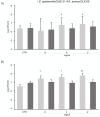Staphylococcus aureus/Staphylococcus epidermidis from skin microbiota are balanced by Pomegranate peel extract: An eco-sustainable approach
- PMID: 39088519
- PMCID: PMC11293756
- DOI: 10.1371/journal.pone.0308211
Staphylococcus aureus/Staphylococcus epidermidis from skin microbiota are balanced by Pomegranate peel extract: An eco-sustainable approach
Abstract
The imbalance in skin microbiota is characterized by an increased number of pathogens in respect to commensal microorganisms. Starting from a skin microbiota collection, the aim of this work was to evaluate the possible role of Pomegranate (Punica granatum L.) Peel Extract (PPE) in restoring the skin microbiota balance acting on Staphylococcus spp. PPE was extracted following green methodology by using n-butane and the Dimethyl Ether (DME) solvents and analyzed for phytochemical composition and antimicrobial activity. The PPE antimicrobial action was evaluated against Gram +, Gram - bacteria and yeast reference strains and the most effective extract was tested against the main skin microbiota isolated strains. PPE extracted with DME showed the best antimicrobial action with MICs ranging from 1 to 128 mg/mL; the main active compounds were Catechin, Quercetin, Vanillic acid and Gallic acid. The PPE in DME anti-adhesive effect was examined against S. epidermidis and S. aureus mono and dual-species biofilm formation by biomass quantification and CFU/mL determination. The extract toxicity was evaluated by using Galleria mellonella larvae in vivo model. The extract displayed a significant anti-adhesive activity with a remarkable species-specific action at 4 and 8 mg/mL against S. epidermidis and S. aureus mono and dual-species biofilms. PPE in DME could represent an eco-sustainable non-toxic strategy to affect the Staphylococcal skin colonization in a species-specific way. The innovation of this work is represented by the reuse of food waste to balance skin microbiota.
Copyright: © 2024 D'Arcangelo et al. This is an open access article distributed under the terms of the Creative Commons Attribution License, which permits unrestricted use, distribution, and reproduction in any medium, provided the original author and source are credited.
Conflict of interest statement
The authors have declared that no competing interests exist.
Figures






Similar articles
-
The anti-biofilm potential of pomegranate (Punica granatum L.) extract against human bacterial and fungal pathogens.Biofouling. 2013 Sep;29(8):929-37. doi: 10.1080/08927014.2013.820825. Epub 2013 Aug 1. Biofouling. 2013. PMID: 23906229
-
Encapsulated pomegranate peel extract as a potential antimicrobial ingredient from food waste.J Sci Food Agric. 2024 Nov;104(14):8720-8733. doi: 10.1002/jsfa.13698. Epub 2024 Jun 28. J Sci Food Agric. 2024. PMID: 38940545
-
Effectiveness of co-cultured Myristica fragrans Houtt. seed extracts with commensal Staphylococcus epidermidis and its metabolites in antimicrobial activity and biofilm formation of skin pathogenic bacteria.BMC Complement Med Ther. 2024 Oct 31;24(1):380. doi: 10.1186/s12906-024-04675-z. BMC Complement Med Ther. 2024. PMID: 39482677 Free PMC article.
-
The bioactivity and applications of pomegranate peel extract: A review.J Food Biochem. 2022 Jul;46(7):e14105. doi: 10.1111/jfbc.14105. Epub 2022 Feb 6. J Food Biochem. 2022. PMID: 35128669 Review.
-
Recent advances in pomegranate peel extract mediated nanoparticles for clinical and biomedical applications.Biotechnol Genet Eng Rev. 2024 Dec;40(4):3379-3407. doi: 10.1080/02648725.2022.2122299. Epub 2022 Sep 18. Biotechnol Genet Eng Rev. 2024. PMID: 36117472 Review.
Cited by
-
Investigating the Effect of Enzymatically-Derived Blackcurrant Extract on Skin Staphylococci Using an In Vitro Human Stratum Corneum Model.Pharmaceutics. 2025 Apr 8;17(4):487. doi: 10.3390/pharmaceutics17040487. Pharmaceutics. 2025. PMID: 40284482 Free PMC article.
-
Almond Hull Extract Valorization: From Waste to Food Recovery to Counteract Staphylococcus aureus and Escherichia coli in Formation and Mature Biofilm.Foods. 2024 Nov 28;13(23):3834. doi: 10.3390/foods13233834. Foods. 2024. PMID: 39682909 Free PMC article.
-
Natural compounds in the fight against Staphylococcus aureus biofilms: a review of antibiofilm strategies.Front Pharmacol. 2024 Nov 20;15:1491363. doi: 10.3389/fphar.2024.1491363. eCollection 2024. Front Pharmacol. 2024. PMID: 39635434 Free PMC article. Review.
References
MeSH terms
Substances
LinkOut - more resources
Full Text Sources
Molecular Biology Databases
Miscellaneous

